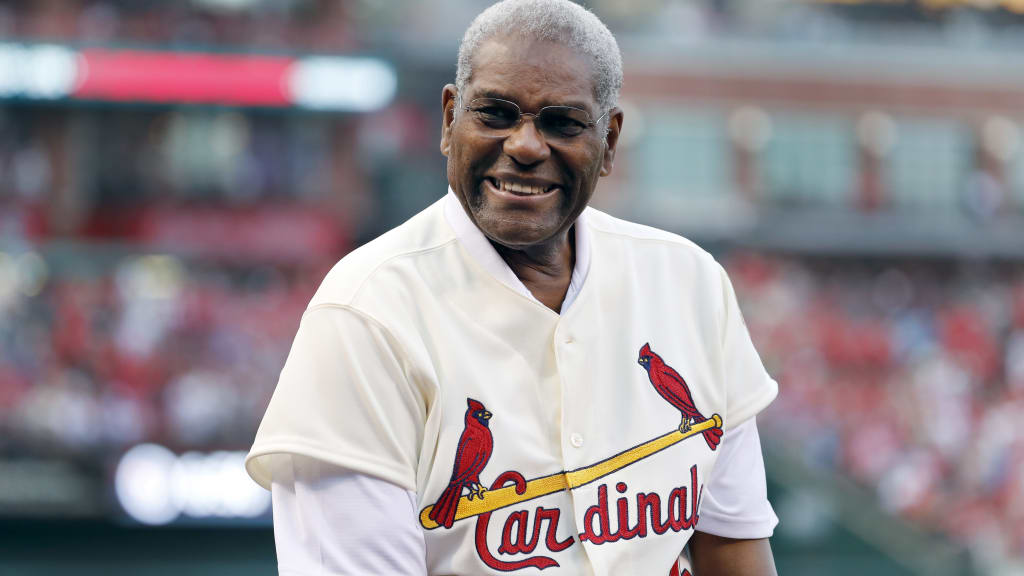
As a Cardinals fan, you grow up with certain undeniable heroes, depending on your generation. My grandfather adored Stan Musial. My father’s favorites were Lou Brock, Mike Shannon and Ken Boyer. I was fortunate enough to have my childhood dominated by Ozzie Smith and Willie McGee. Afterward came Mark McGwire, Jim Edmonds, Albert Pujols, Adam Wainwright, Yadier Molina. My sons’ stars are likely to be Jack Flaherty and Dylan Carlson. One of the many gifts of being a Cardinals fan is that the team keeps providing them. There are no real lean periods in St. Louis. There’s always something, and someone, to cheer for.
But Bob Gibson always felt different. He loomed larger -- an almost mystical figure for the fanbase -- than everyone else, who were merely legends. Gibson was more like a grand auk, a regal figure whose mere presence seemed to elevate anyone in his proximity. Every year on Opening Day (except for this year) the Cardinals have all the members of the club’s Hall of Fame return to St. Louis, wearing loud red jackets as the city -- which has shut down for the day -- greets them and the Clydsdales horses parading around the field. Everyone who can make it back always does. But there was something particularly special about having Bob Gibson there. You’d have inner-tier Hall of Famers in the room … but when Gibson walked in, everyone hushed. That’s Bob Gibson. The only thing you did when you were in the room with Bob Gibson is think, "Oh my gosh I’m in the room with Bob Gibson."
My colleague Anthony Castrovince has already written an excellent, thorough remembrance of Gibson, so I won’t go through his career highlights, though there are so many -- from the year he was so good they changed the rules for him, to the beginning of his career with the Harlem Globetrotters, to how he was so skilled with the bat that I’m not sure peak Gibson wouldn’t have led this season’s Cardinals in homers.
But to me and a generation of Cardinals fans, Gibson was so much more than a baseball player. In fact, to me, he was barely a baseball player at all. He pitched his last game for St. Louis almost exactly one month before I was born. By the time I was watching every Cardinals game, Gibson was just the recent Hall of Famer coming back to the ballpark every once in a while. My earliest memories of him are of my heroes talking about him with reverence, him dropping by the broadcast booth with Jack Buck and Mike Shannon and both of those very loquacious men going quiet and just listening to him. Gibson was only 46 years old in 1982, the first year I watched Cardinals baseball, but he already felt like a statue made flesh. Ozzie Smith once said that talking to Bob Gibson made him feel stronger -- and that is how everyone thought of him. He felt like an energy source you could draw from.
It all sprung from who he was as a player and as an outspoken and fiery leader … one who had also dealt with more than his fair share of strife. In a great piece about Gibson in The Undefeated a couple of years ago, several Cardinals players and Gibson’s biographer, Lonnie Wheeler, talked about how the St. Louis teams of Gibson’s day were unusually close, and how they tackled the civil rights era head on. “They were very uncommon in how they responded to racial issues in that day and age,” Wheeler told The Undefeated. “The black and white players always spoke about racial topics. If there was a difference of opinion, they aired it in the clubhouse and hashed it out. Gibson was a touchstone for that. He and Bill White would confront people who said something offensive. Those things would be reported to him -- even by white players, sometimes. So everybody had a stake in that attitude, that mentality of the Cardinals.” Tim McCarver, Gibson’s forever catcher, always said that Gibson “educated” him on so much. The whole team surrounded him, and followed him.
As he got older, and fought pancreatic cancer, he continued to be this sort of influence. Jack Flaherty, an outspoken leader on social justice issues this year, said that Gibson used to text him before games, and that talking to Gibson was a “completely different animal.” Gibson’s last game was 20 years before Flaherty was born. But Flaherty knew. You didn’t have to see Gibson pitch to know, and you didn’t even necessarily have to meet him. You just needed to hear the awe in the voice of anyone who had.
Every Gibson story ends up being personal, even if you never met him. When people describe watching Gibson pitch, or what it was like to meet him, they rarely just describe him. They describe themselves, how they felt when they saw him. That’s the difference between a great athlete and a transcendent one. Gibson felt bigger than baseball. He felt bigger than everything.
I met Gibson once; it’s a funny story and an indicative one, though one perhaps not entirely appropriate to readers of a family website. (You can read it on a non-family website here). I have been dining out on that story for years. People look at me a little differently after I tell it. You met Bob Gibson? You sat next to Bob Gibson? Bob Gibson is a such a large figure that he almost didn’t seem real. I have a Bob Gibson jersey -- a Cooperstown Collection throwback -- that I wear to Cardinals games, special ones, postseason games, or Opening Day. It’s gorgeous and exquisite. It honestly might be my most expensive piece of clothing. And every time I wear it, people physically stop me when they see it. One elderly man, at least in his eighties, stopped me last year. “Great jersey,” he said. “Bob Gibson. Now that’s a man.” He had misty eyes just saying it. Bob Gibson. Now that’s a man. And so much more.
